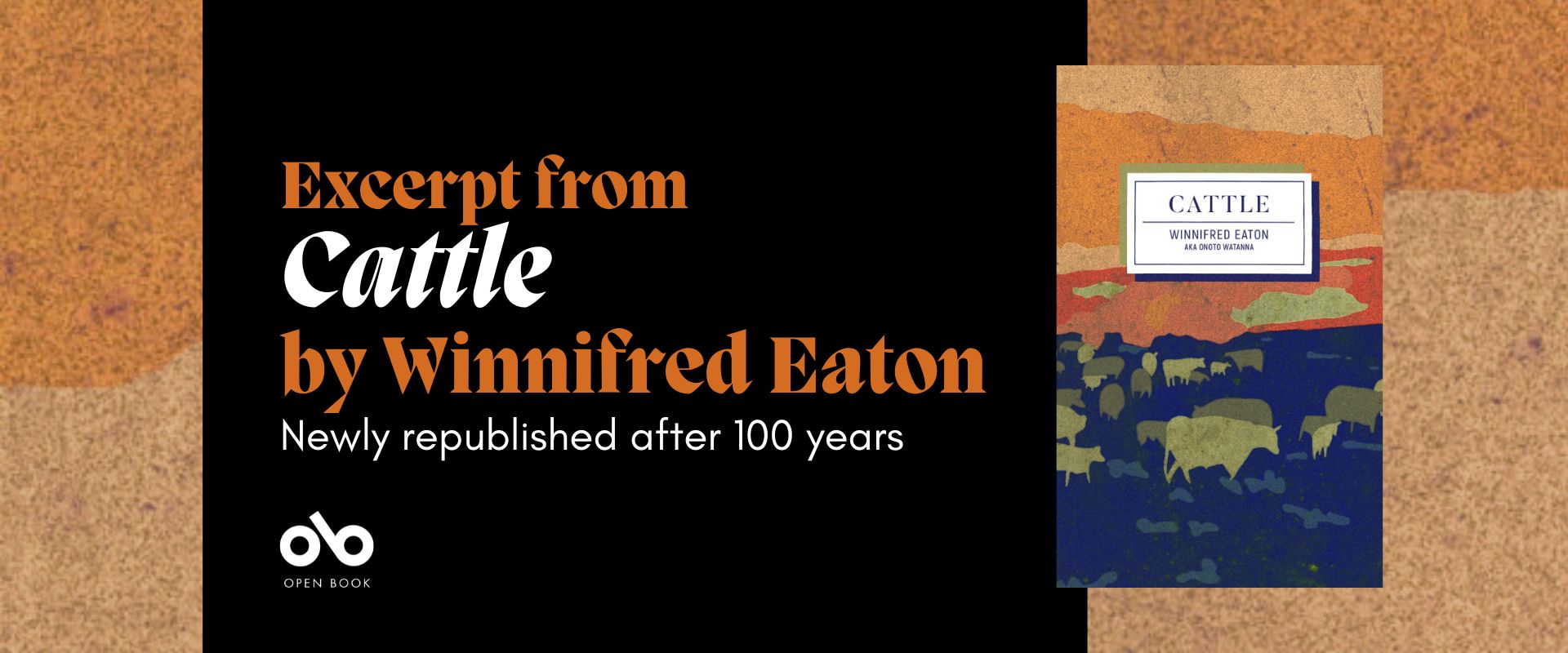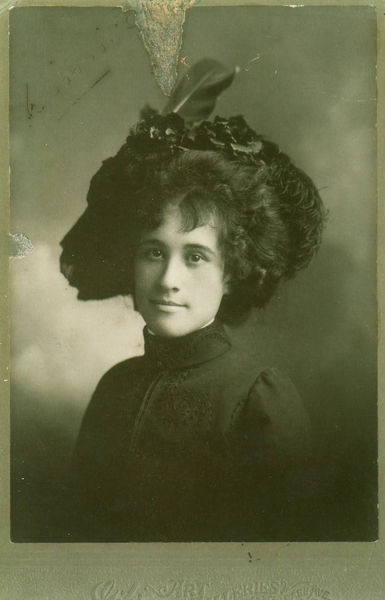Read an Excerpt from Cattle by Early Asian-Canadian Literary Superstar Winnifred Eaton, Newly Republished After 100 Years
Winnifred Eaton was not only one of the first North American writers of Asian descent to publish fiction in English, she was one of the most successful novelists of her day. Born in Montreal to an English father and a Chinese mother, she published her first story at 20 and went on to publish numerous novels, short stories, and even work on several early Hollywood films.
Her novel, Cattle, however (written later in her life when she and her second husband moved to Alberta to ranch) was not what was expected from the bestselling writer. Eaton herself described the novel as "act[ing] like a bomb" in her publisher's office. She was informed that "it had caused more heated discussion and argument than any manuscript [in] years". A close friend at her publisher wrote her what Eaton described as "a fatherly letter" in which he deplored the book, chastising her that "Cattle was a man’s subject". The story follows a corrupt rancher whose bullying ways endanger the livelihood, and even lives, of many around him, all as a pandemic creates unimagined complications. A raw portrait of settler colonialism, it does not flinch from describing the racism and violence Eaton witnessed in Alberta.
Eaton defied the odds and got the book published in 1923, when she was in her late 40s, and it has endured as her most timeless and impactful work. Newly republished by Invisible Publishing as part of their Throwback series, it features a new introduction by Dr. Lily Cho. Royalties from sales of Cattle will benefit Central Alberta Women’s Emergency Shelter.
We're sharing an excerpt here today, courtesy of Invisible, in which Dr. Cho contextualizes the novel and its impact.
Excerpt from Cattle by Winnifred Eaton:
Introduction by Dr. Lily Cho
Cattle is the novel that Winnifred Eaton’s publishers did not want to publish. It is a major departure from her earlier, commercially successful novels and stories. While Eaton recounts her publishers lamenting the brutality of the story, they also grappled with the problem of selling a novel that is devoid of the Japanese or Chinese American characters and themes through which Eaton and her sister, Edith Maude Eaton (who wrote under the name Sui Sin Far) had become famous. Eaton’s previous novels drew from her Chinese and British ancestry. While her sister Edith’s writing focused on Chinese and Chinese American characters, Winnifred’s writing featured Japanese and Japanese American heroines and themes. Although she was born in Canada and lived much of her life in Canada, Cattle, first published in 1923, is one of only two novels in Eaton’s oeuvre that is set in Canada. The other, His Royal Nibs (1925), is also about life in the Canadian West. Of the two though, Cattle is distinct for the courage of its darkness.
In Cattle, Eaton whisks her readers away to a place as strange and new as any she has taken them before: a cattle ranch in Alberta run by a violent and brutish rancher named Bull Langdon. As his name suggests, Langdon’s character is larger-than-life. He dominates the rooms he steps into and the people in them. However, in many ways, the real star of the novel is Nettie, a teenaged orphan who works as a domestic helper on the ranch. Nettie’s resourcefulness and deep goodness shine against the starkness of life on a cattle ranch in early twentieth century Alberta. The novel is not propelled by Bull Langdon’s ruthlessness, but rather by following how Nettie carves hope out of hopelessness.
Cattle has been repeatedly referred to as a page-turner. The novel began as a synopsis for a film script, based on a true story that Eaton heard after she had moved to Alberta to live on a ranch in the foothills of the Rocky Mountains. It is filmic in its pacing, dialogue, and vivid scene-setting. Eaton loved riding her horse alone across the foothills and the depth of her feeling for the prairies is threaded throughout the novel.
Terrible things do happen in this novel. There is illness and death, violence and, particularly, sexual violence. While we cannot look away from the horrors that are a part of the novel, it does ask important questions about what justice looks like in a place and time when so many wrongs cannot be made right through formal means. Eaton demands much more of her characters, and of her readers, than mere acquiescence to situations of profound inequity and injustice. There is a kind of justice that unfolds in the novel where some wrongs are not exactly made right — indeed, Eaton shows her readers every wrong cannot be righted — but wrongdoers are still brought into the thrall of suffering.
While Eaton was, in many ways, ahead of her time in terms of her depiction of the challenges and struggles that her women characters faced, she was very much of her time in terms of her representation of Indigenous peoples and racialized others. Eaton is often understood by academics as a writer who humanized racial others, particularly Asian Americans, in that she was one of the first mixed race Canadian authors to write about racialized characters. Through Eaton, Anglophone readers got stories of romance and adventure where the central characters were Japanese and Japanese American. Still, to contemporary readers, these depictions are reminders that good intentions can carry with them their own problems and biases. Nevertheless, Eaton recognizes in Cattle that Western Canada is not a purely white space and writes into the novel the diversity of people and culture that she encountered in her own life.
Canada is a settler colonial nation and Cattle gives to readers some of the texture of the viciousness that is part and parcel of what it means to colonize a place when colonizers take land that is not theirs to take, operate businesses, start families, and build communities in a place that does not belong to them. Settlement can sound benign. Cattle is a riveting reminder that the act of settlement is a violent process. It is a form of theft and it leaves Canadians living under the long shadow of that wrong. The novel does not give its readers a long view of these wrongs. It takes us into the heart of them and bring us up close to the violence and pain that haunts Canada still.
Your CanLit News
Subscribe to Open Book’s newsletter to get local book events, literary content, writing tips, and more in your inbox
Finally, reading Cattle in the wake of the mass death event that is the COVID-19 pandemic, there is a new poignancy to Eaton’s narration of the arrival of the Spanish Flu, or more precisely, the Great Influenza Pandemic of 1918, in the latter part of the novel. Eaton’s story of the pandemic offers a potently fresh view of the one that would be unleashed on the world a century later. Readers can follow a little-told story of the pandemic then and the pandemic now: that of its effects on rural and isolated communities. Stories of pandemics and plagues have tilted toward tracking sites of population density and the spread of the disease in places where people are most closely clustered such as cities and, in our contemporary era, cruise ships and airports. How a plague travels when people live far away from each other, far from the concentrations of medical expertise and supplies in urban areas, is a story that has not been told enough.
Although the novel is not primarily about a plague, the influenza pandemic catalyzes every thread of the plot. Eaton’s plague is neither a metaphor nor a historical event in the backdrop of the novel. It is both anchor and destroyer. Here, the plague ushers in justice for the novel’s central characters and sets to some right that which had been wrong. Writing in March 2020, during that frantic early period of the Covid-19 pandemic, Jill Lepore declared, “Every plague novel is a parable.” Riffing on Camus, Lepore goes on to argue that the “plague novel is the place where all human beings abandon all other human beings.” And yet, Eaton’s novel insists upon the opposite of abandonment. The novel’s heroes run into known danger. Cattle tells its readers that abandonment is not the answer. Against the idea of Canadian literature as thematically bound to survival, Eaton tells us that survival is not enough.
The publication history of this novel gives readers a window into the complex ways that Eaton’s identity circulated in North America and Britain. The novel was first published in Great Britain in 1923 by Hutchinson & Co, under the pen name Onoto Watanna, then published in Canada the same year by Musson, again under the name Onoto Watanna. The book was then published in the USA by W.J. Watt in 1924 under the name Winnifred Eaton (Onota Watonna) [sic]. The pseudonym in the parenthesis of the US edition may first appear to be a typo but the book certainly circulated with that odd spelling on top of the established oddity of her more established pseudonym, Onoto Watanna. Long before Cattle was published, Eaton had wanted to begin to publish under her own name and to move away from the Japanese-inflected authorial identity she had developed. The many different versions of her name attached to this novel across three different national contexts offers some sense of the difficulty of that transition. There are no clean breaks between her Japanese persona and the Anglocentrism of her given name. Her Chinese heritage remains invisible in all of her names. Throughout her life, Eaton’s identities continue to converge and complicate her identity as a writer.
Winnifred Eaton is one of the most important North American writers of the early twentieth century. She was incredibly prolific. She did not hide her mixed-race identity, despite the racism of her time. She brought into the world some of the earliest stories of Asian and Asian American women in English-language literature. Given Eaton’s incredible legacy, Cattle is uniquely important. It is the first time that she writes a novel about Canada. Cattle is also one of the earliest novels of Western Canada in Canadian literature. It is also rare in that it takes readers to one of the most important cultural and economic sites in this part of the world: the cattle ranch. Cattle takes far more risks than His Royal Nibs. Cattle is a darker story, daring to bring readers to a less comfortable and, I would argue, much more interesting place. For a writer who spent her entire career writing with a canny understanding of how to give readers stories that they wanted, and thus what stories would sell, Eaton gambles here on a story with a hard edge. After decades of what she termed “fairy-like stories of Japan,” it is with Cattle that Eaton finally begins to write “tales of the things and people I have known” (Birchall). She decided, with Cattle, that she would write with the “strong, hot pen of a man” (Birchall). Readers of Cattle can celebrate the emergence of Winnifred Eaton as a writer who fought to finally tell a story of a life that she knew and with a voice that carries the clarity and strength of the fullness of that knowing.
Sources
Birchall, Diana, “Winnifred Eaton.” The Dictionary of Literary Biography. Gale Cengage Learning, 2009.
Lepore, Jill, “What Our Contagion Fables are Really About.” The New Yorker. March 23, 2020.
_____________________________________________________
Winnifred Eaton Babcock Reeve (1875-1954) was a popular early Asian North American author, journalist, screenwriter and playwright whose best known works were published under the pen-name Onoto Watanna, a controversial persona that she assumed for over two decades.
Dr. Lily Cho is vice-provost and associate vice-president (International) at Western University. Formerly she served as Associate Dean, Global and Community Engagement for the Faculty of Liberal Arts & Professional Studies at York University. She was also appointed as professor in the department of English and writing studies within the Faculty of Arts and Humanities. Dr. Cho has published books on Chinese restaurants and the relationship between human rights and creative expression. Her book Mass Capture: Chinese Head Tax and the Making of Non-Citizens (McGill-Queens) won the Association for Asian American Studies 2023 Book Prize for Outstanding Achievement (Multidisciplinary).





